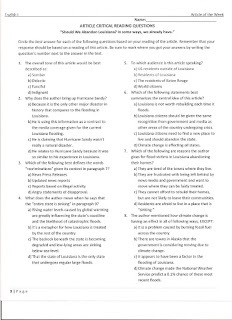Kelly Gallagher, Readicide
Folder of Literacy Student Engagements
Bridging English,
Ch. 5
When Kids Can’t Read
Reading Better, Reading Smarter
Mary E. Styslinger, Julianne Oliver Ware, Charles W. Bell,
and Jesse L. Barrett “What Matters:
Meeting Content Goals through Teaching
Cognitive Reading Strategies with Canonical Texts”
I’ve always liked Gallagher’s writing, as he tends to state
things that seem like they should be super obvious, but one might never think
about the fact that there is a process in learning to teach them. Gallagher
reveals how there are two ways of ruining reading instruction: overdoing it and
underdoing it. Whether students like or dislike the book is not an issue so
much as getting value from it. To avoid both, challenging texts need to be
framed, and this framing often comes in the form of a reading “goal” for the
students to be aware of. A teacher can slow down and introduce themes on the
second read through of a section, or read aloud and pause to reflect and
understand. The way this is done guides how students who are following along
read the text alone.
The Styslinger et al. article has a related goal: “we wanted
to deepen student comprehension, but we wanted to do so in ways that aligned
with our commitment to study the matter and art of the literary works as well”
(54). The article shows the results of several employments of cognitive reading
exercises in various classrooms. These examples demonstrate what Gallagher was
saying pretty clearly. The students were able to read complex texts with
modeled cognitive reading strategies. The article points out some issues, such
as the concern that teaching strategies in a vacuum could lead to them not
recognizing other contexts to apply the strategies in; it is also possible to
inundate students with strategies or to overemphasize strategies over the
content of the text. My personal feeling is that strategies are ideally taught
on a case by case basis. Students could be identified as needing support in
visualization and then made to do the visualization exercises. That seems like
a simple conclusion; the point is that the technique we utilize is not chosen
at random or merely to satisfy a standard.
This week I reviewed many of the pre-, during-, and post-
reading strategies in our various textbooks. One thing I had forgotten about
this section of Bridging was the
claim that “the debate over teaching literary form strongly resembles the
debate over teaching grammar” (143). Isn’t it strange that there are so many
aspects to our content area we have to justify teaching? Of course, my
experience in internship so far has shown that even if we thought this was
totally useless, the state would be having kids take standardized tests over
it. Fortunately, it has also seemed like creating engaging formal analysis
lessons is less difficult than I had anticipated, at least when framed
properly. My CT introduces her kids to a swathe of literary devices in a long
power point presentation, but each slide is interactive and asks the students
to locate examples of formal elements in literature in the works they already
know. Formal analysis can be a method of understanding more than just
literature in schools. Those patterns and ideas exist everywhere.
Briefly looking over the literacy engagements in this week’s
readings, the “Text Coding Symbols” document caught my eye. My CT has made a
push for her students to learn how to annotate texts this year, which is
similar to this exercise. I had never given it a lot of thought, but students
(particularly in 9th grade) may not have a great concept of how to
take notes or make sense out of texts simply using a pen. It’s a form of
analysis that we often do not assess, but could be even more valuable than the
lessons we actually grade. I think making this process part of the curriculum
is an excellent idea that encourages students to begin thinking analytically
about texts as they are reading and responding to them.
The “Do” I have selected for this week is an example of a
vocabulary exercise I had my students do over my teaching week. After reading
their weekly scientific article, the students were asked to select five words
they did not recognize and fill out this worksheet. At first, I thought
students might take the easy way out and pick words they understood to make
things easy on themselves, but to my surprise every one of them followed the
directions and demonstrated that they understood their words at the end of
about twenty minutes of time to look the words up and get to know them. I have
marked out this student’s name, but wanted to show how s/he responded. I think this was a good assignment that
demonstrates how formal analysis can be engaging and productive.

